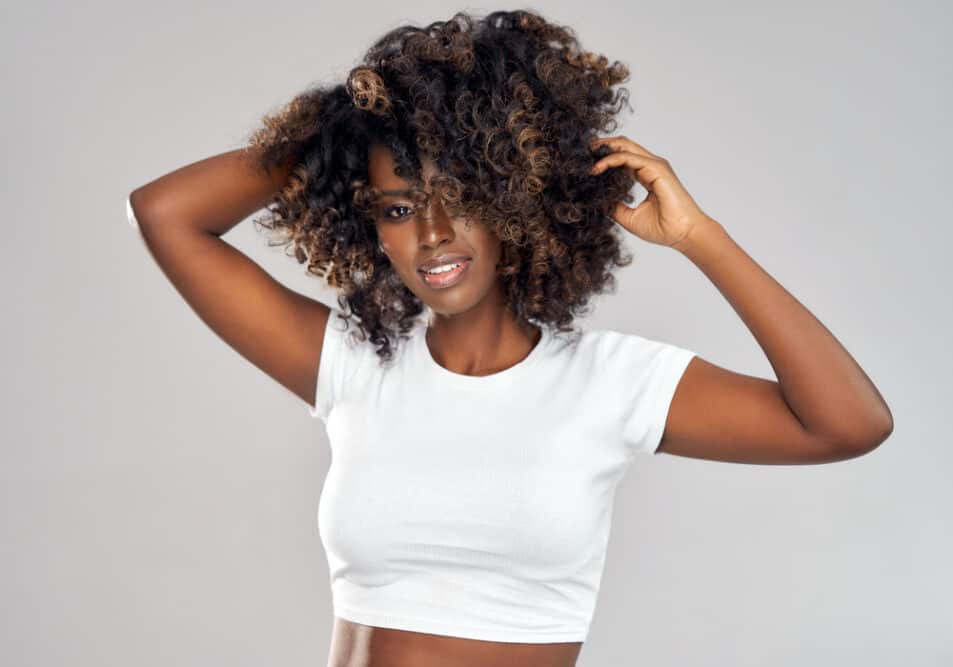
Most women with natural hair have dealt with tangling, split ends, and other hair issues. But many have never heard of a phenomenon called hair webbing.
Believe it or not, you may be dealing with it right now without being aware of it. One thing’s for sure - when you find out what hair webbing is and how to deal with it, you’ll be one step closer to giving your curls the care they need.
Table of Contents
What Is Hair Webbing?
Hair webbing is what happens when your hair takes on the look of spider webs. Hair strands latch on and stick to neighboring strands, creating a matrix of tangled hair (i.e., a spider web of individual strands) and single-strand knots. Most people with naturally curly hair have dealt with hair webbing at one point or another, and for some, it’s an ongoing issue.

What Causes Hair Webbing?
Now, let’s move on to the potential culprits behind hair webbing. Hair webbing may be caused by a few things, including:
- Buildup - Many curly girls use sticky or gooey products to slick down their hair or keep it defined. But when you apply products like these to your hair on a regular basis and fail to wash them out thoroughly, they can build up and cause your hair to “web.” Buildup can also lead to much more than hair webbing - think split ends and breakage.
- Hair dryness - Hair webbing may also be caused by dehydrated hair. When your hair is deprived of moisture, its structure begins to change. Over time, your hair cuticles (the outer layer of your hair) will become damaged and raised up, and this damaged hair is what causes webbing in many cases. The raised cuticles of each of your strands act like velcro and snag each other. After a while, you’ll have hair webs everywhere.
- Split ends - Have you ever noticed that the ends of your hair clump together when you need a trim? That’s because hair webbing is caused by split ends. Split ends are super common with fragile curly hair, and they have an annoying way of making your hair difficult to detangle.
- Infrequent detangling - Many of us wear our hair in protective styles, which is totally fine in most cases. But when you leave your style in for too long, shed hair can cause your roots to tangle. This gives way to webbing.
After reading about the above hair webbing causes, chances are you were able to pinpoint the reason why your hair is webbed. But even if you haven’t, keep on reading to find out how to fix it.

How to Fix Hair Webbing
Fixing hair webbing is much easier than you might think, especially with the right information. In this section, we’ll walk you through some foolproof remedies you can use to fix hair webbing fast.
Moisturize Your Hair
Being that one of the most common causes of hair webbing is hair dryness, the logical first step is to up your hair moisturizing routine. Moisturized hair cuticles lay flat and are less likely to latch onto other strands.
Here are some of the best ways to moisturize your curly hair:
Do a Deep Conditioning Treatment
Deep conditioners are known to save even the driest curls within minutes, and there are a variety of great deep conditioners that you can try. To banish hair dryness, though, be sure to choose a moisturizing deep conditioner that’s full of hydrating oils and humectants.
To get the best results from your deep conditioning session, wash your hair thoroughly with a clarifying shampoo and then apply the product all throughout your hair.
Rinse the product out after 5 to 10 minutes and enjoy your hydrated hair. Note: It may take several deep conditioning treatments to see results - once a week is a good frequency to start with initially. You can adjust this frequency as you monitor your hair's hydration and determine what's needed to keep your curl properly hydrated.

Use a Leave-in Conditioner Spray
A leave-in spray is one of the best ways to get a quick daily dose of moisture. All it takes is a few spritzes, and you’re on your way. Use a leave-in spray in conjunction with other curl moisturizing techniques for the best results.
Moisturize and Seal
If you’ve never moisturized and sealed, you’re really missing out. This technique works wonders for anyone who has high porosity hair that doesn’t hold onto moisture for very long.
It involves applying a moisturizer (water-based leave-in or cream) and then a sealant (Jamaican black castor oil, jojoba oil, coconut oil, or shea butter) to seal in the moisture for days.
Many notice that once they start moisturizing and sealing their hair every wash day, they notice less dryness and tangles because their hair is getting enough moisture.

Use a Sulfate-free Shampoo or Co-wash Hair Products
Sulfate-based shampoos are detrimental to curls due to their drying nature. Ongoing use of these shampoos results in dry hair that’s prone to webbing. The solution?
Use non-sulfate shampoos or co-washes to clean your hair without leaving it dry or brittle.
Limit Heat Styling
Heat styling is a well-known driver of hair dryness. It damages your hair cuticles and leaves them frayed and brittle.
To give your hair some time to recover, put down the heat tools and try some heatless styles. Alternatively, you can turn down the heat on your heat tools and use a heat protectant every time.

Clarify Your Hair Regularly
Preventing hair buildup is essential if you want to keep hair webbing at bay. So, do yourself a favor and deep cleanse your hair every so often.
You don’t need to clarify your hair every wash day - most people do it monthly. But we must stress that your hair care routine needs to be tailored to your unique hair.
If you notice product buildup on your roots, reach for a clarifying shampoo right away and give your curls a proper cleansing. You can deep condition your curls after clarifying them to add moisture.
Get Trims (as Needed)
Regular trims may be necessary to keep the webs away. They keep frayed ends under control and minimize the Velcro effect. As a general rule, you should be getting your ends trimmed as needed (usually no more than every 12-15 weeks or so).
If you heat-style or chemically process your hair, you may need trims more often. And remember that trims are very different from a full-blown cut. You should only cut off up to ½ of an inch of hair (hopefully much less) - any more than that, and you’re getting a cut.
Don’t Leave Protective Styles in Too Long
Since wearing your hair in a given style for too long can result in webbing, it’s imperative to take down protective styles on time. Don’t wear any style for longer than two months, and always detangle your hair after taking it down.
Before breaking out the comb, try to remove the webbing with your hands first. Doing so will reduce your chances of breakage.
What Happens If You Don’t Fix Hair Webbing?
We encourage you to try one or more of the above remedies today to eliminate those annoying hair webs. If you don’t, you could pay a hefty price.
Hair webbing is associated with several negative consequences that you need to know about:
- Painful and frustrating detangling sessions. Webbed hair is prone to tangles and matting, which makes detangling your hair a chore. Try to finger-detangle your curls for a more gentle approach.
- Breakage and damage. Every time you wrestle with your webbed hair, the probability of hair breakage increases. So, it’s best to remedy the webbing issue as soon as you possibly can.
- Frizz. Frizziness is yet another unfortunate problem associated with hair webbing. It can ruin even the best hair days. Some ladies also experience wet frizz in addition to dry frizz.

What Does Hair Webbing Look Like?
Hair webbing looks like spider webs, where your hair strands lock on and adhere to nearby hair strands, creating a spider web of tangled hair and knots. People with naturally curly hair have a higher probability of experiencing webbing.
Why Is My Hair Webbing?
Your hair may be webbing due to a combination of factors such as buildup, hair dryness, split ends, and infrequent detangling. Using sticky or gooey products without thoroughly washing them out can cause buildup, leading to hair webbing, split ends, and breakage.
Hair webbing can also result from dehydrated hair, where damaged and raised hair cuticles snag onto each other, forming tangled webs. Split ends, common in fragile curly hair, can make detangling difficult and contribute to webbing. Lastly, infrequent detangling, especially when wearing protective styles for extended periods, can cause shed hair to tangle at the roots, giving way to hair webbing.
Why Is My 4C Natural Hair Webbing?
Your 4C natural hair may be experiencing webbing due to buildup from hair products, breakage, split ends, and tangled hair strands. Hair webbing in 4C hair can also be caused by dryness, where the hair cuticles become damaged and raised, leading to strands of hair snagging onto each other and forming tangled webs.
Also, split ends, particularly common in fragile 4C hair, can make detangling more difficult and contribute to webbing. Finally, infrequent detangling, especially when wearing protective styles for long periods, can cause shed hair to tangle at the roots, further promoting hair webbing.
Why Does My Hair Feel Like Its Matting and Webbing?
Your hair might feel like it's matting and webbing due to a combination of issues such as product buildup, dryness, the presence of split ends, and not detangling frequently enough.
When sticky or thick hair care products accumulate on your strands without being washed out properly, they can cause the hair to stick together, resulting in matting and webbing. Adopting a hair care routine that involves consistent moisturizing, detangling, trimming, and using appropriate hair care products is crucial.
How Do You Get Rid of Webbing?
To eliminate hair webbing, you can implement several strategies targeting the underlying causes. First, moisturize your hair regularly to combat dryness, including deep conditioning treatments, using a leave-in conditioner spray, and applying the moisturize-and-seal technique.
Next, switch to a sulfate-free shampoo or co-wash to cleanse your hair without causing dryness or brittleness. Limit heat styling, which can damage hair cuticles and lead to webbing, and opt for heatless styles or use heat protectants when necessary. Regularly clarify your hair using a clarifying shampoo to prevent product buildup, which can contribute to the webbing.
Get trims as needed every 12-15 weeks to keep split ends under control and minimize the velcro effect. Finally, avoid leaving protective styles in for too long, and always detangle your hair after taking down a protective style, using your hands first to reduce breakage. Addressing these factors can effectively combat hair webbing and promote healthier hair.
- How To Get a Rat’s Nest Out of Your Hair
- How Do You Untangle Matted Hair Without Cutting It
- How to Detangle Natural Hair Without Breakage
- How To Fix Wet Frizz Curly Hair
There you have it - a clear definition of hair webbing, what it’s like, and what to do about it. This hair webbing crash course is everything you need to recognize and fix hair webbing fast.
We hope that the tips and information in this article have been helpful to you and wish you the best of luck with your curls!




